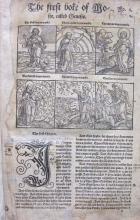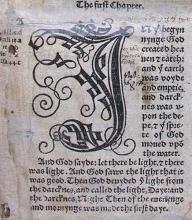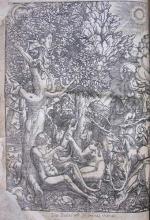The opening of Genesis from the Coverdale Bible (1535) and Matthew's Bible (1537)
The first printings of the English Bible were rather cloak and dagger affairs. All of the first editions were printed abroad at unspecified locations. This reflects the power of the Catholic Church in England in the early 16th century, and the desire of the younger Henry VIII to promote himself as amongst the most pious and Christian princes of the day. The Church recognised only the Latin Vulgate version of the Bible and viewed any attempt at translation into a vernacular as heretical.
William Tyndale was the most influential of the English translators. He published the first English New Testament (1526), but was betrayed to the authorities of the Holy Roman Empire in Antwerp by an English agent before he could finish his translation of the rest of the Bible, and burned for heresy in 1536. Even as Tyndale burned the tide was changing. The year before Tyndale's death Miles Coverdale, another exile, had published the first complete English Bible, probably in Antwerp, and the year before that King Henry had abolished the jurisdiction of the Catholic Church in England, after Rome's refusal to grant his divorce from Catherine of Aragon.
Only with the subsequent rise of sympathetic figures in Henry's government such as Thomas Cromwell and the new archbishop of Canterbury, Thomas Cranmer, was the King's licence given to the printing of the first version of the English Bible with royal approval in 1537. This was known as Matthew's Bible, as it named its translator as Thomas Matthew, but this is usually considered a pseudonym, either for the editor (John Rogers) or more probably (as the text is basically an amalgam of Tyndale's and Coverdale's translations) for Tyndale himself. Even with the royal licence the text was still printed on the continent, possibly in Antwerp.
Both given by Thomas Baker.


